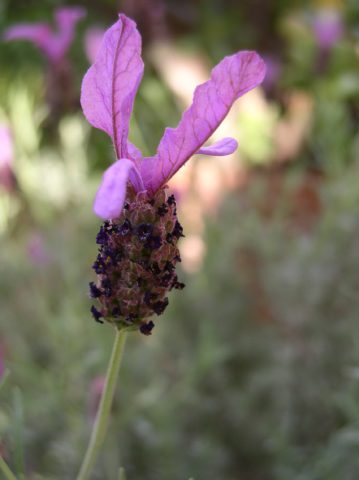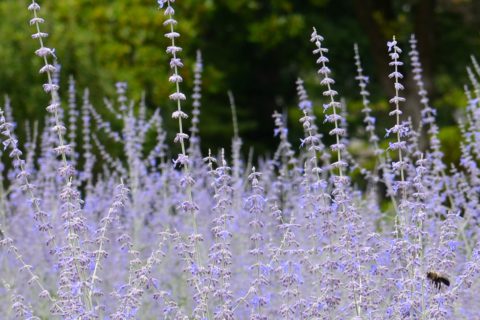
Bees and butterflies are attracted to lavender flowers. Derek Finch photo.
In April and May, nurseries and plant sales are bursting with plants. From shrubs and trees to annuals and perennials, there are many gorgeous choices.
As our summers get hotter and drier, it is worth seeking out plants that will thrive, once established, with little water. Here are a few favorite drought-tolerant plants.
Mediterranean plants
Mediterranean plants do well in sunny locations. Consider lavender, rosemary, sage and similar plants. In addition to attractive flowers and evergreen or semi-evergreen leaves, these plants add fragrance to the garden. Imagine yourself brushing up against a rosemary plant along your walkway, or picking lavender flowers for your home.
Lavender

Spanish lavender. debaird photo.
There are three primary types of lavender: English lavender, hedge lavender and Spanish lavender.
- English lavender has a compact, busy habit, small flowers and a sweet fragrance.
- Hedge lavender grows somewhat larger. It is more heat-tolerant.
- Spanish lavender makes great hedges or borders. Its flowers are distinctive, with rabbit-eared bracts.
Lavender plants grow best in full sun, with good drainage. All lavender requires annual pruning.
Here are some tips on choosing and growing lavender from Swansons Nursery. And more lavender choices, along with growing and pruning tips, from Oregon Live.
Rosemary
As Great Plant Picks says, this Mediterranean native “has been cultivated in gardens for centuries, and for a number of very good reasons!” It is a handsome evergreen shrub which may flower as early as January, depending on the weather and the clone. It is commonly used as a culinary herb. You can shear rosemary into a hedge and use its fragrant branches in floral arrangements.
Here is Sunset’s guide to choosing rosemary varieties.
Sage and Russian sage
Sage (salvia) also works well in a sunny garden. There are both culinary and ornamental varieties. Some varieties are very drought-tolerant. Others do best with regular to occasional watering.

Lilac sage (Salvia verticillata ‘Purple Rain’). Great Plant Picks photo.
Lilac sage (Salvia verticillata ‘Purple Rain’) is one of many salvia choices. It is a sprawling plant, with attractive spade-shaped leaves, that produces plum-purple flowers from July until frost. Bees love it.
Here are some of Ciscoe Morris’ favorite sage varieties and his advice on growing sage.

Russian sage (Perovskia atriplicifolia). Robert Lyle Bolton photo.
Russian sage (Perovskia atriplicifolia) is a hardy perennial with small grey-green leaves. Tall, airy sprays of lavender-blue flowers bloom in late summer. It is vigorous, hardy and very drought tolerant once established.
Other drought-tolerant plants
- Here are ideas for drought-tolerant plants from Sky Nursery.
- Great Plant Picks has a list of drought-tolerant plants for sun.
- The Oregonian/Oregon Live has a long plant list and tips on managing hot, dry weather in the garden.
- The Natural Yard Care Program has a list of drought-tolerant plants.
How to plant and water a new plant
Get your new purchases off to a good start by planting and watering them properly. Give the roots space to spread out in the planting hole and water deeply when you plant. This will help your new purchase to be more successful.
Check out our short video on how to plant and water a new plant.
Even drought-tolerant plants need water
“Drought-tolerant” does not mean your plants will need no water. Every plant and tree will need regular watering for the first two or three years until the roots are firmly established.
After drought-tolerant plants are established, don’t assume that you can just turn the water off. In the summer, we generally get very little rain. And our summer temperatures are increasing. Most plants, including trees, will need some supplemental water over the season.
Soaker hoses or drip irrigation are an efficient way to water deeply. Find out more about watering wands, hoses and sprinklers in this short video.
Water timers also make watering easier. You might consider a timer that turns the water on and off and on again, so it can soak in slowly and deeply. Find out more about timers in this short video.
Compost and mulch reduce summer water needs
Compost helps sandy soils to retain water in dry summers, and it helps clay soils to drain well in the wet winter months. Compost also enables plant roots to grow deeply, reducing the potential for drought stress.
As we said in last week’s blog post, mulch is important to help your plants survive the hot, dry summer. Mulch insulates the soil and helps it retain water. It also reduces weeds, helps prevent compaction from winter rains and feeds the soil.
Good choices for mulch include compost, arborist wood chips, fallen leaves and coarse-textured bark. For details about types of mulch and their uses, watch this video.
